When it comes to the six best regional bonsai traditions in Asia, you’ve got to check out Japanese bonsai, with its stunning simplicity and wabi-sabi elegance. Then there’s Chinese penjing, which captures lively miniature scenes steeped in Taoist philosophy. Don’t overlook Korean bunjae, showcasing nature’s rugged beauty! And how could I forget Vietnamese Hòn Non Bộ, rich in mythology? Southeast Asia’s tropical bonsai thrives too, full of vibrant flora. Curious about American adaptations and tree symbolism? There’s so much more to explore!
Quick Takeaways
- Japanese bonsai emphasizes beauty through simplicity and the wabi-sabi philosophy, showcasing styles like Chokkan and Moyogi.
- Chinese penjing creates miniature landscapes reflecting Taoist beliefs, highlighting resilience and longevity through carefully crafted gnarled trees.
- Korean bunjae focuses on natural asymmetry and the unique characteristics of rugged trees, emphasizing a deep connection to nature.
- Vietnamese hòn non bộ represents miniature landscapes infused with mythology and cultural narratives, enhancing local identity through artistic expression.
- Southeast Asian tropical bonsai utilizes local flora such as Ficus and Bougainvillea, flourishing in the humid climate and showcasing vibrant aesthetics.
Japanese Bonsai Tradition
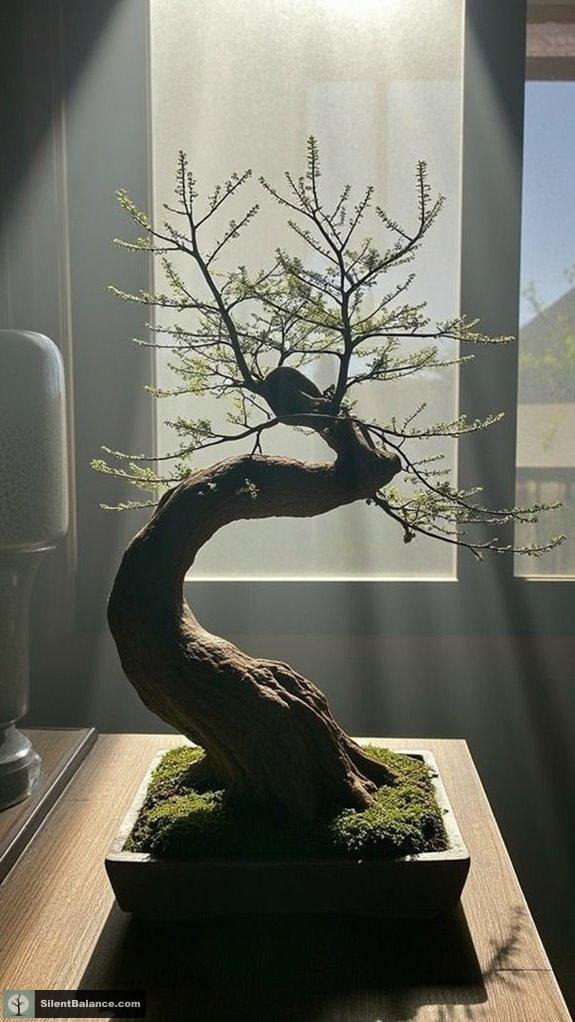
When you immerse yourself in the world of Japanese bonsai tradition, it’s like stepping into a serene garden where ancient art meets spiritual practice—and, trust me, it’s a journey worth taking!
Have you ever wondered how a tiny tree evokes such immense beauty? Through simplicity, asymmetry, and a philosophy called wabi-sabi, bonsai captures nature’s essence perfectly. You’ll find styles like Chokkan and Moyogi, each with its own charm. Bonsai art spread to wider Japanese culture from religious confines, enriching its depth and appeal, while also reflecting Buddhist symbolism that enhances the contemplative experience.
Plus, techniques like meticulous pruning and clever wiring guarantee it stays healthy while putting on a show. Bonsai isn’t just a hobby; it’s a dance between art and nature, begging for your touch. Ready to sculpt your own masterpiece?
Chinese Penjing Tradition
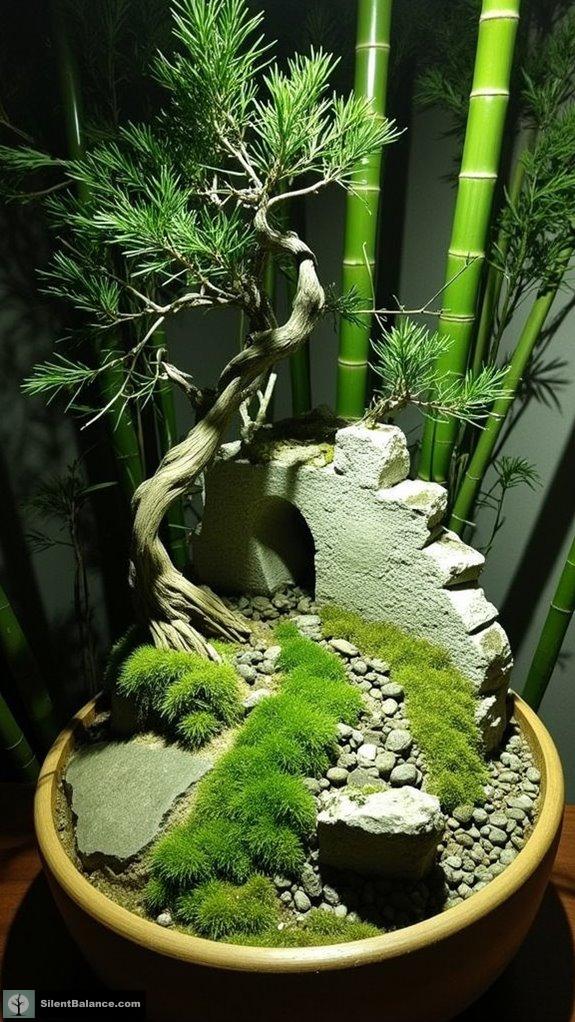
Envision stepping into a tranquil Chinese garden, where the art of penjing unfolds in miniature environments that whisper stories of nature’s wonders. These stunning scenery, dating back to the Tang Dynasty, don’t just capture trees; they embody the very essence of Taoist beliefs. Ever seen a gnarled tree proudly defy time? That’s penjing doing its magic—inviting you to ponder longevity and liveliness. The intricate design reflects spiritual symbolism deeply rooted in the culture. With techniques like wiring and root shaping, master artisans craft these living sculptures, inspired by the three categories of penjing.
Korean Bunjae Tradition
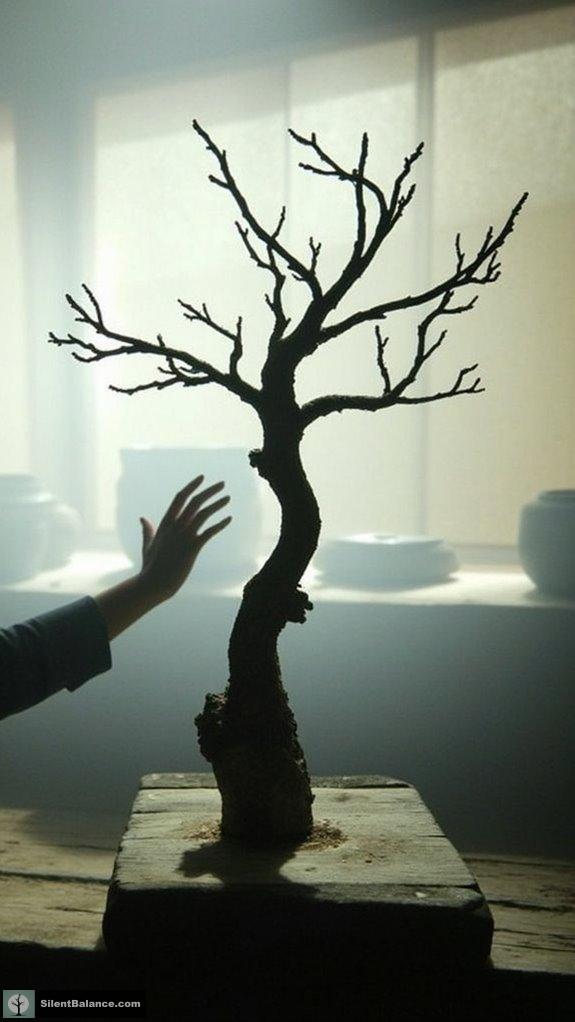
Korean bunjae, the enchanting art of miniature trees, really captures the spirit of its surroundings, much like penjing does in China, but with its own unique flair.
Imagine a tree, rugged and wild, shaped by Korea’s temperate climate. That’s bunjae for you!
Unlike the polished symmetry of Japanese bonsai, bunjae embraces natural asymmetry—it’s like nature’s way of saying, “I’m beautifully imperfect.”
With techniques tailored for native species, patience is key.
Vietnamese Hòn Non Bộ Tradition
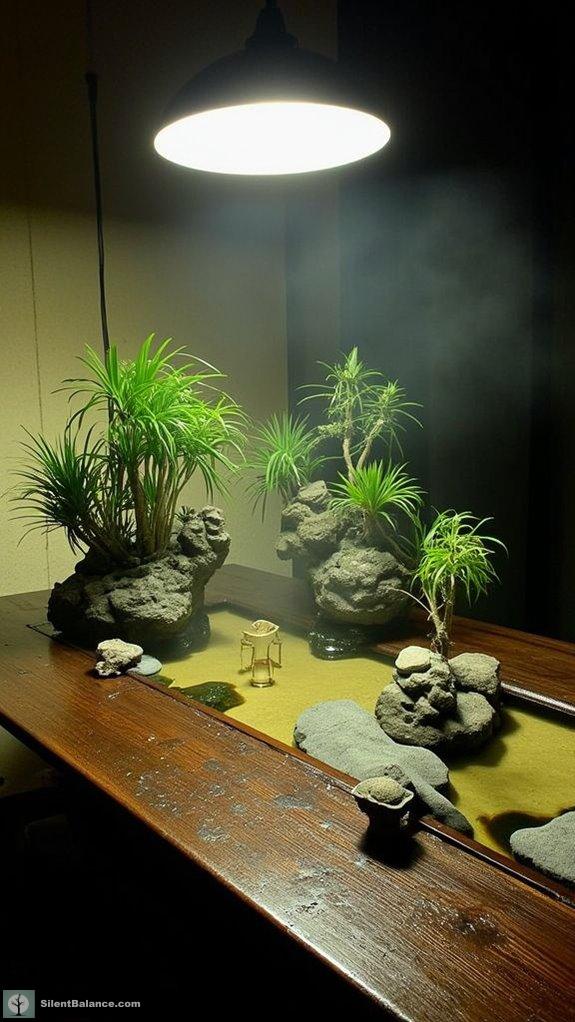
Nestled within the vibrant tapestry of Vietnamese culture, Hòn Non Bộ is more than just a pretty sight; it’s a miniature masterpiece that tells a story.
Imagine scaling down mountains, lush trees, and tranquil waters into a small basin. That’s Hòn Non Bộ for you! This art form isn’t just bonsai; it’s a full-blown narrative—think islands, forests, and mini structures all in one enchanting display.
Scaling down nature’s beauty, Hòn Non Bộ crafts enchanting narratives through miniaturized islands, forests, and tranquil waters.
Using tropical plants like sago palms, it brings Vietnamese mythology to life. The intricate designs reflect the sense of belonging found in various art forms, making it a powerful expression of cultural identity.
Isn’t it fascinating how a tiny scenery can resonate such powerful cultural beliefs? Immerse yourself in creating your own little world; it’s both empowering and delightful!
Southeast Asian Tropical Bonsai Traditions
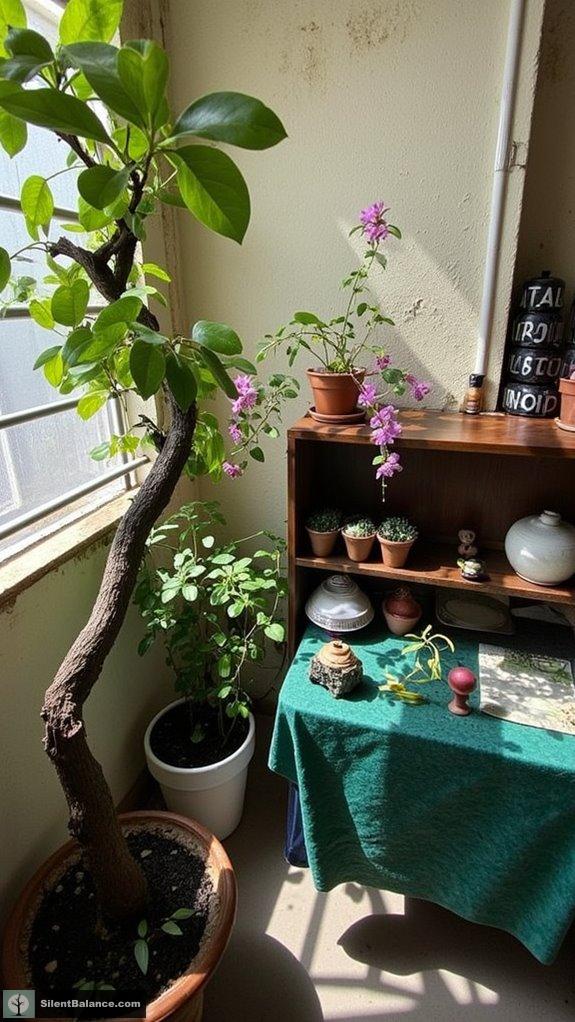
When it comes to the art of bonsai in Southeast Asia, the tropical climate isn’t just a backdrop; it’s a main character in the story!
Here, I’m increasingly drawn to species like Ficus and Bougainvillea, which thrive in our humidity and warmth.
Forget winter dormancy—year-round growth means I can shape and nurture my trees regularly.
There’s something almost magical about those vibrant flowers against lush foliage, don’t you think?
Plus, being in-tune with local flora and culture adds a unique twist to my bonsai journey.
It’s all about embracing the rhythm of tropical life while steering my bonsai creations with purpose!
Western / American Adaptations of Asian Bonsai
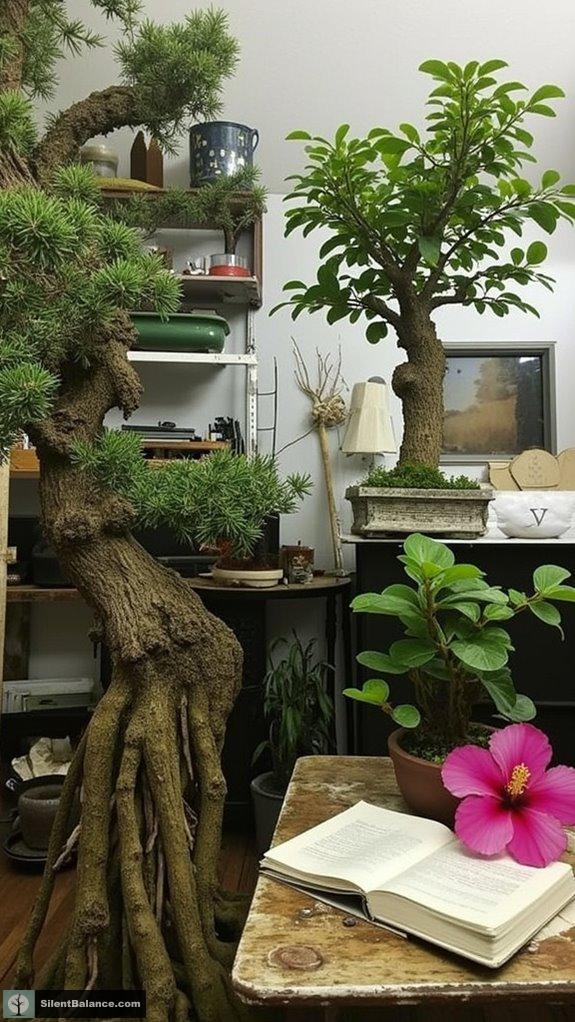
Bonsai artistry isn’t just confined to Asia anymore; it’s making waves across the American scenery, blending traditional practices with local flair.
Here are four vibrant components of American bonsai:
- Native Species: Trees like bald cypress and California oak bring new aesthetics.
- Innovative Techniques: Think outside the box, adapting styles that fit local vibes.
- Cultural Independence: We’re ditching those Japanese tools for a truly American touch!
- Indoor Treasures: Tropical species like figs and hibiscus thrive indoors, expanding our bonsai horizons.
Doesn’t it make you want to jump into the bonsai craze?
Let’s shape our artistry, shall we?
Bonsai Tree Symbolism
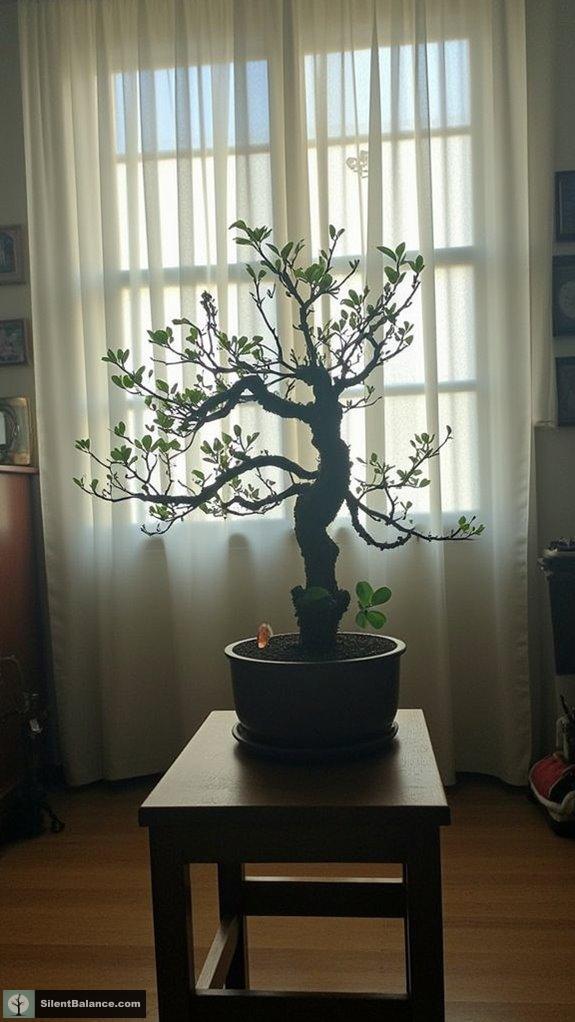
In the world of bonsai, each tiny tree carries profound meaning. These living sculptures symbolize harmony, balance, and peace, embodying nature’s beautiful order.
Have you ever noticed how a well-crafted bonsai conveys a sense of equilibrium?
Cultivators seek for that sweet spot between natural beauty and human influence, a true zen moment!
Each species adds a unique twist: the Chinese Elm speaks to inner strength, while the Cherry Blossom reminds us of life’s fleeting nature.
Caring for these miniature environments fosters patience and mindfulness.
Tree Symbolism
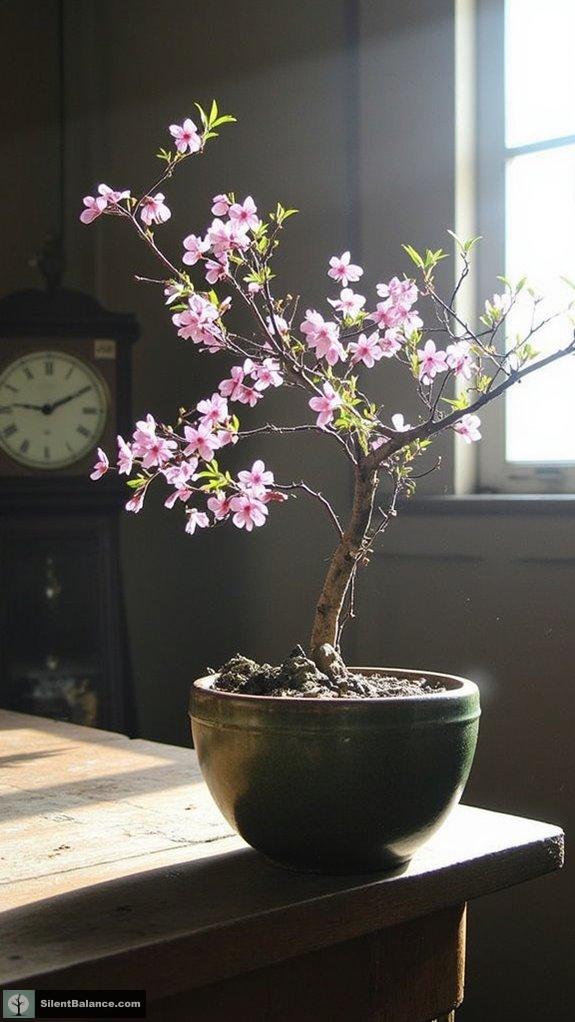
Tree symbolism in the world of bonsai is a fascinating tapestry woven from culture, tradition, and the deep connections humans have with nature.
Here’s what you’ll find:
- The Buddhist Pine symbolizes enlightenment in Chinese tradition.
- Japanese cherry blossoms embody the beauty of transience.
- Certain fruit-bearing bonsai represent fertility and renewal.
- In various cultures, trees can symbolize protection, longevity, and balance.
Isn’t it intriguing how each species carries a story?
Bonsai gives us a glimpse into different viewpoints, merging careful craftsmanship with rich cultural narratives, reminding us, each tree has its own journey.
Questions and Answers
What Types of Trees Are Commonly Used in Asian Bonsai Traditions?
When I explore Asian bonsai traditions, I find pines, maples, and cherries are commonly used. Their unique shapes and seasonal colors captivate me, proving these trees can bring beauty and tranquility to any space.
How Do I Choose a Bonsai Tree for Beginners?
To choose a bonsai, I recommend picking hardy species like Ficus or Juniper. I focus on plants that are easy to care for and adapt well to my indoor or outdoor environment. That makes my journey enjoyable!
What Tools Are Essential for Bonsai Care?
When I care for my bonsai, I always use essential tools: shears for trimming, concave cutters for clean cuts, and a root rake for soil management. Investing in quality tools makes all the difference in nurturing my trees.
Can Bonsai Be Grown Indoors or Outdoors?
Envision a tiny forest in your living room; bonsai can thrive indoors with the right light and humidity. I’ve learned careful placement and species selection allow me to cultivate these living sculptures beautifully indoors.
How Often Should Bonsai Trees Be Watered and Fertilized?
I only water my bonsai when the soil’s dry, adjusting for season and environment. I fertilize regularly during the growing season, ensuring I’m attentive to my tree’s needs to promote healthy growth.
References
- https://www.bokksu.com/blogs/news/bonsai-the-delicate-art-of-japanese-miniature-trees
- https://wazakurajapan.com/blogs/news/differences-in-bonsai-styles-article
- https://www.bonsaiempire.com/origin/bonsai-history
- https://kokorocares.com/blogs/blog/bonsai-a-living-tradition-in-japanese-culture
- https://forum.bonsaimirai.com/t/american-bonsai/1974
- https://thunderstruckbonsai.com/a-little-bonsai-history-for-beginners/
- https://deeperjapan.com/the-history-of-bonsai
- https://www.bjornbjorholm.com/bonsai-history-japan/
- https://www.toki.tokyo/blogt/2015/9/16/the-art-of-japanese-bonsai
- https://www.bonsai-nbf.org/blog-archive/2019/10/7/penjing-master-weighs-in-what-are-the-differences-between-bonsai-and-penjing
- 11 Tree Slice Mosaic Home Decor Ideas - October 21, 2025
- 11 Pop Wood Mosaic Home Decor Ideas - October 21, 2025
- 15 Best Geometric Mosaic Patterns Using Reclaimed Wood - October 21, 2025

